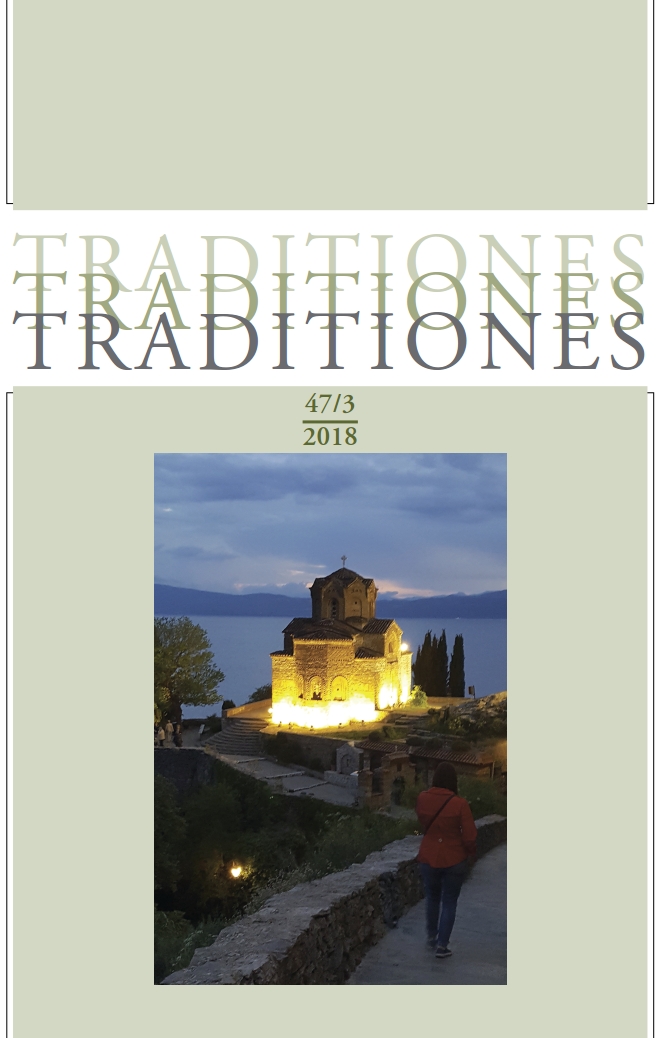Protiintuitivnost in ritualna učinkovitost v zgodnjemodernem karelijskem zdravljenju: uporaba teorije ritualne kompetence
DOI:
https://doi.org/10.3986/Traditio2018470305Ključne besede:
Karelia, healing rituals, rituals, sages, counterintuitiveness, ritual competence theory // Karelija, zdravilni obredi, obredi, modreci, protiintuitivnost, teorija ritualne kompetencePovzetek
This article presents an application of Thomas E. Lawson and Robert N. McCauley’s ritual competence theory in order to study two early modern Karelian sages and their rituals, especially their healing rituals. I analyse how this application presents ritual efficacy in archived healing narratives, and how such an efficacy affects interpretations of the rituals and their performers.
***
V članku je predstavljena uporaba teorije ritualne kompetence Thomasa E. Lawsona in Roberta N. McCauleya na primeru dveh zgodnjemodernih karelijskih modrecev in njunih obredov, posebej zdravilnih. Avtorica analizira, kako ta raba predstavlja ritualno učinkovitost v arhiviranih zdravilnih pripovedih in kako učinkovitost vpliva na interpretacijo obredov in njihovih izvajalcev.
Prenosi
Literatura
Barrett, Justin L. 2002. Smart Gods, Dump Gods, and the Role of Social Cognition in Structuring Ritual Intuitions. Journal of Cognition and Culture 2 (3): 183–193.
Barrett, Justin L. and E. Thomas Lawson. 2001. Ritual Intuitions: Cognitive Contributions to Judgements of Ritual Efficacy. Journal of Cognition and Culture 1 (2): 183–201.
Bell, Catherine. 1997. Ritual: Perspectives and Dimensions. Oxford: Oxford University Press.
Boyer, Pascal. 1994a. Cognitive Constraints on Cultural Representations: Natural Ontologies and Religious Ideas. In: Lawrence Hirschfeld and Susan Gelman (eds.), Mapping the Mind. Cambridge: Cambridge University Press, 39–67.
Boyer, Pascal. 1994b. The Naturalness of Religious Ideas: A Cognitive Theory of Religion. Berkeley, Los Angeles and London: University of California Press.
Boyer, Pascal. 2000. Evolution of the Modern Mind and the Origins of Culture: Religious Concepts as a Limiting Case. In: Peter Carruthers and Andrew Chamberlain (eds.), Evolution and the Human Mind. Cambridge: Cambridge University Press, 93–112.
Boyer, Pascal and Harold C. Barrett. 2005. Evolved Intuitive Ontology: Integrating Neural, Behavioural and Developmental Aspects of Domain-specificity. In: David Buss (ed.), Handbook of Evolutionary Psychology. Hoboken, NJ: John Wiley, 96–118.
Keil, Frank C. 1979. Semantic and Conceptual Development. Cambridge, MA: Harvard University Press.
Lawson, Thomas E. and Robert N. McCauley. 1990. Rethinking Religion: Connecting Cognition and Culture. Cambridge: Cambridge University Press.
McCauley, Robert N. 2011. Why Religion Is Natural and Science Is Not. Oxford: Oxford University Press.
McCauley, Robert N. and Thomas E. Lawson. 2002. Bringing Ritual to Mind: Psychological Foundations of Cultural Forms. Cambridge: Cambridge University Press.
Pyysiäinen, Ilkka. 2003. How Religion Works: Towards a New Cognitive Science of Religion. Leiden: Brill.
Siikala, Anna-Leena. 2002. Mythic Images and Shamanism: A Perspective on Kalevala Poetry. Helsinki: Academia Scientiarum Fennica (FF Communications; 280).
Spelke, Elizabeth, Ann Phillips and Amanda Woodward. 1995. Infants’ Knowledge of Object Motion and Human Action. In: Daniel Sperber, David Premack and Ann Premack (eds.), Causal Cognition: A Multidisciplinary Debate. New York: Oxford University Press, 44–78.
Stark, Laura. 2006. The Magical Self: Body, Society and the Supernatural in Early Modern, Rural Finland. Helsinki: Academia Scientiarum Fennica (FF Communications; 290).
Uro, Risto. 2016. Ritual and Christian Beginnings: A Socio-Cognitive Analysis. Oxford: Oxford University Press.
Whitehouse, Harvey. 1995. Inside the Cult: Religious Innovation and Transmission in Papua New Guinea. Oxford: Clarendon Press.
Whitehouse, Harvey. 2000. Arguments and Icons: Divergent Modes of Religiosity. Oxford: Oxford University Press.
Whitehouse, Harvey. 2004. Modes of Religiosity: A Cognitive Theory of Religious Transmission. Walnut Creek, CA: AltaMira Press.
Prenosi
Objavljeno
Kako citirati
Številka
Rubrike
Licenca
Avtorji jamčijo, da je delo njihova avtorska stvaritev, da v njem niso kršene avtorske pravice tretjih oseb ali kake druge pravice. V primeru zahtevkov tretjih oseb se avtorji zavezujejo, da bodo varovali interese založnika ter da bodo povrnili morebitno škodo.
Podrobneje v rubriki: Prispevki






